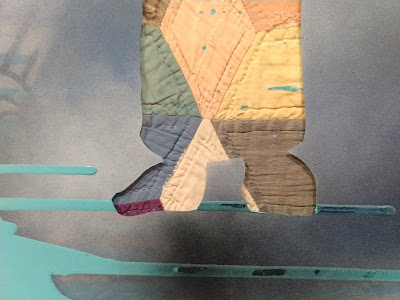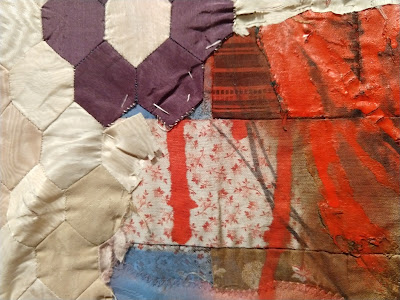I've written about the Sanford Biggers show in two previous posts. Time for a wrap-up.
The piece I liked best in the show was a Tumbling Blocks quilt, with a minimum of paint, overlaid with a dramatic horizontal flame of orange-and-black chevron print. A little bit of black paint made a curvy outline over the old blocks, a sort of half-silhouette of a key shape.
Sanford Biggers, Quilt 17 ( Sugar, Pork, Bourbon)My second favorite was a collage of old quilts, plus a section of curvy stripes made from sequins on a black painted background.
Sanford Biggers, Transition
I liked these quilts because they thoughtfully used large patterned shapes to contrast with and complement the smaller patterns of the vintage pieced quilts. In both cases there was artistry in the composition and care in the construction.
Sadly, I did not see those features in most of the quilts in the exhibit. The artspeak at the entrance to the gallery tells us "the quilts signal their original creator's intent as well as the new layers of meaning given to them through Biggers's artistic intervention." I searched in vain for the new layers of meaning in most of the pieces in the show.
As I mentioned in my first post about this show, I walked in the door as a Biggers skeptic, based on a bit of past knowledge of his work, but would have liked to like this show. Instead I was surprised at the strength of visceral discomfort that hit me in only the first two rooms of the gallery; all those beautiful antique quilts deliberately messed up with paint and tar to no apparent purpose. Perhaps it wasn't the defacing per se that bothered me -- I've been known to repurpose old quilt bits myself -- but the slapdash quality of the defacing.
I went to the museum with two friends, one an artist, one not. When we compared notes all three of us just wanted to get out of there fast. I wasn't there long enough to discover exactly what made me so unhappy, and for that I apologize.
The show will be up through June 26. I'd love to hear what other people think of it, whether I'm alone in my unease.
















